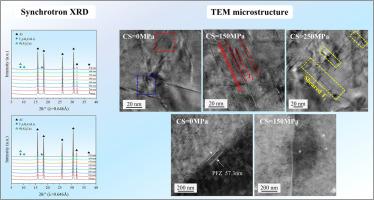Optimizing mechanical properties in Al-Li alloys through synergistic regulation of dislocations and precipitates during creep aging
IF 14.3
1区 材料科学
Q1 MATERIALS SCIENCE, MULTIDISCIPLINARY
引用次数: 0
Abstract
Creep aging is a coupled process that integrates both processing and precipitation strengthening in age-hardening alloys. However, inhomogeneous precipitation resulting from dislocation accumulation can significantly degrade the mechanical properties. In this study, an attempt was made to establish a correlation between creep stress, dislocation density and precipitation strengthening to address the degradation in plasticity. The results show that the application of creep stress does not significantly change the low-angle grain boundaries (LAGBs). The distinct microstructure of the T1 phase and the disappearance of the precipitation-free zones (PFZs) at the grain boundaries (GBs) are the main factors responsible for the improved mechanical properties. The micro-elastic lattice strain induced by creep stress can effectively mitigate the depletion of dislocations by aging precipitation, and the nucleation kinetics of precipitates can be significantly enhanced. During the creep aging process under 150 MPa stress, the T1 phase forms a sandwich structure via interstitial nucleation, with its number density increasing from 2.25 × 1014/m2 to 4.04 × 1014/m2. The dislocation density induced by creep stress also contributes to the narrowing or disappearance of the PFZs at the GBs, further improving the capacity for localized plastic deformation. Finally, the Al-Li alloy with excellent ultimate tensile strength (∼754.0 MPa), yield strength (∼718.1 MPa) and elongation (∼8.8%) was obtained. This study provides strategies for optimizing the microstructure and improving the mechanical properties of Al-Li alloys.

通过对蠕变时效过程中位错和析出相的协同调节优化Al-Li合金的力学性能
蠕变时效是时效硬化合金中加工和沉淀强化相结合的耦合过程。然而,位错积累引起的不均匀析出会显著降低材料的力学性能。在本研究中,试图建立蠕变应力、位错密度和析出强化之间的相关性,以解决塑性退化问题。结果表明,施加蠕变应力对低角晶界没有明显影响。不同的T1相组织和晶界处无析出区(PFZs)的消失是提高力学性能的主要原因。蠕变应力诱发的微弹性点阵应变能有效缓解时效析出引起的位错损耗,使析出相的成核动力学显著增强。在150 MPa应力下的蠕变时效过程中,T1相通过间隙形核形成夹层结构,其数量密度从2.25 × 1014/m2增加到4.04 × 1014/m2。蠕变应力引起的位错密度也有助于GBs处pfz的变窄或消失,进一步提高了局部塑性变形的能力。最终获得了具有优异的极限抗拉强度(~ 754.0 MPa)、屈服强度(~ 718.1 MPa)和伸长率(~ 8.8%)的Al-Li合金。本研究为优化Al-Li合金的组织和提高其力学性能提供了策略。
本文章由计算机程序翻译,如有差异,请以英文原文为准。
求助全文
约1分钟内获得全文
求助全文
来源期刊

Journal of Materials Science & Technology
工程技术-材料科学:综合
CiteScore
20.00
自引率
11.00%
发文量
995
审稿时长
13 days
期刊介绍:
Journal of Materials Science & Technology strives to promote global collaboration in the field of materials science and technology. It primarily publishes original research papers, invited review articles, letters, research notes, and summaries of scientific achievements. The journal covers a wide range of materials science and technology topics, including metallic materials, inorganic nonmetallic materials, and composite materials.
 求助内容:
求助内容: 应助结果提醒方式:
应助结果提醒方式:


